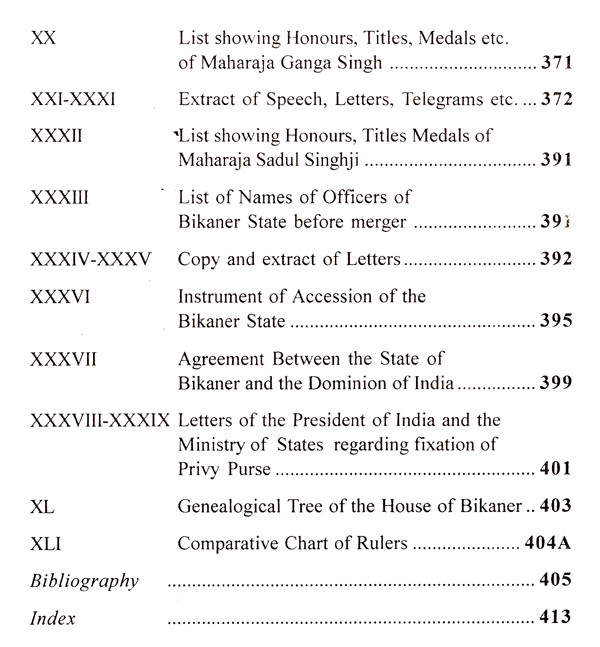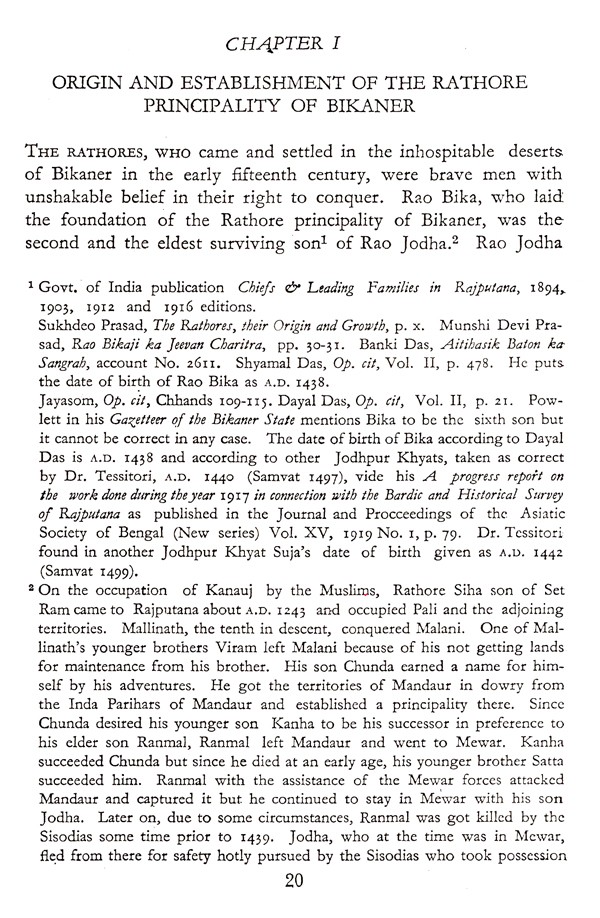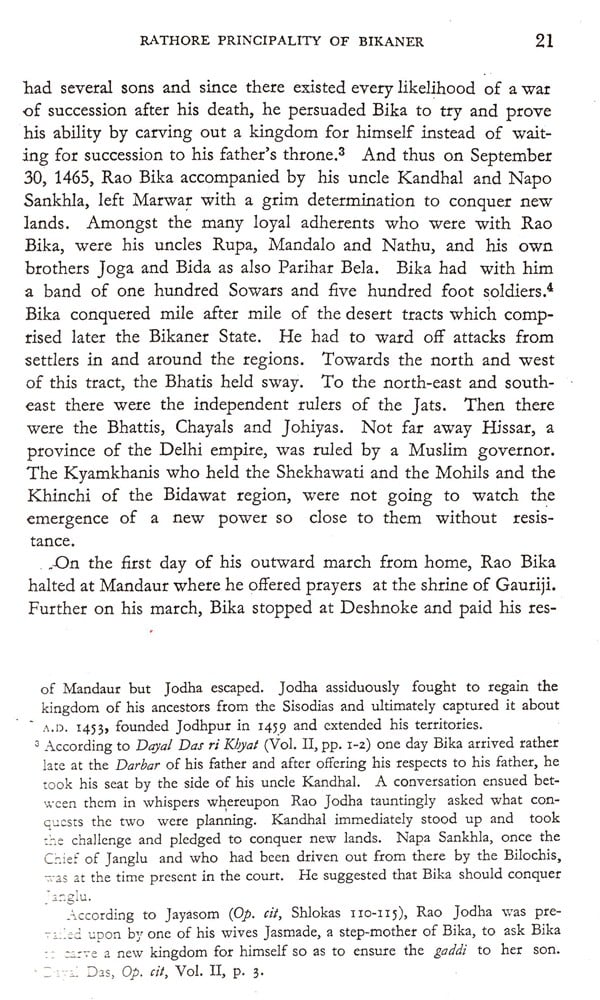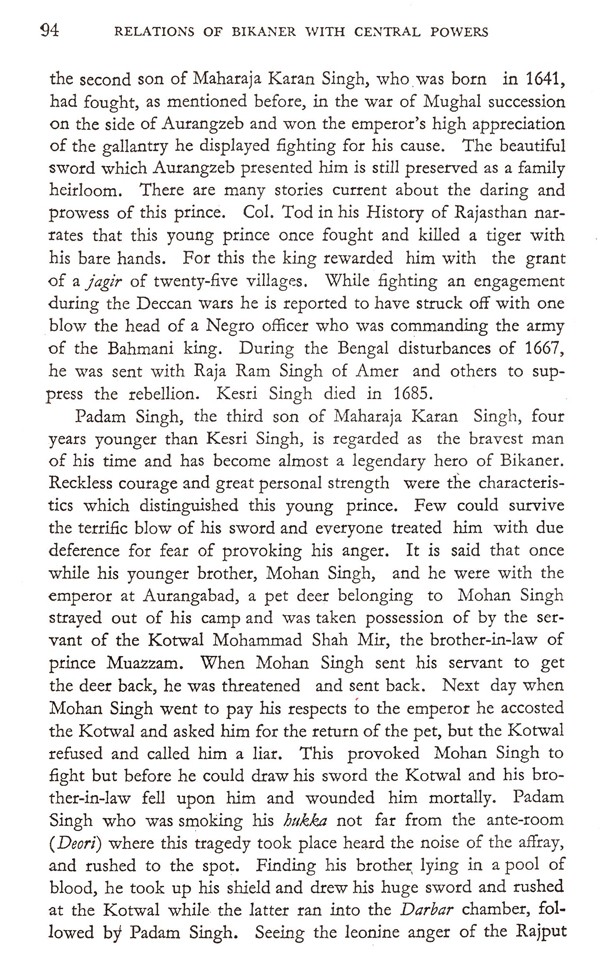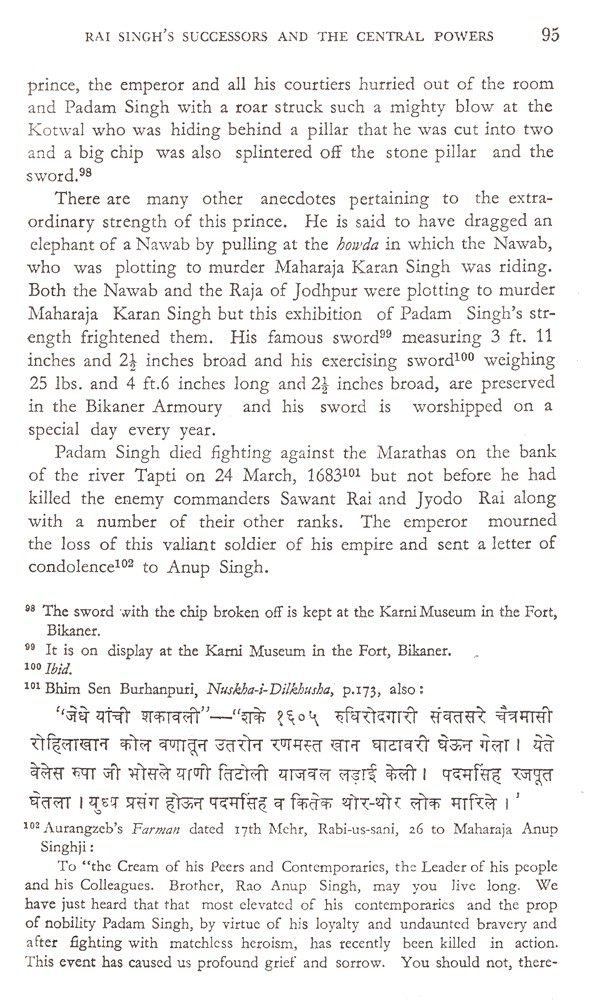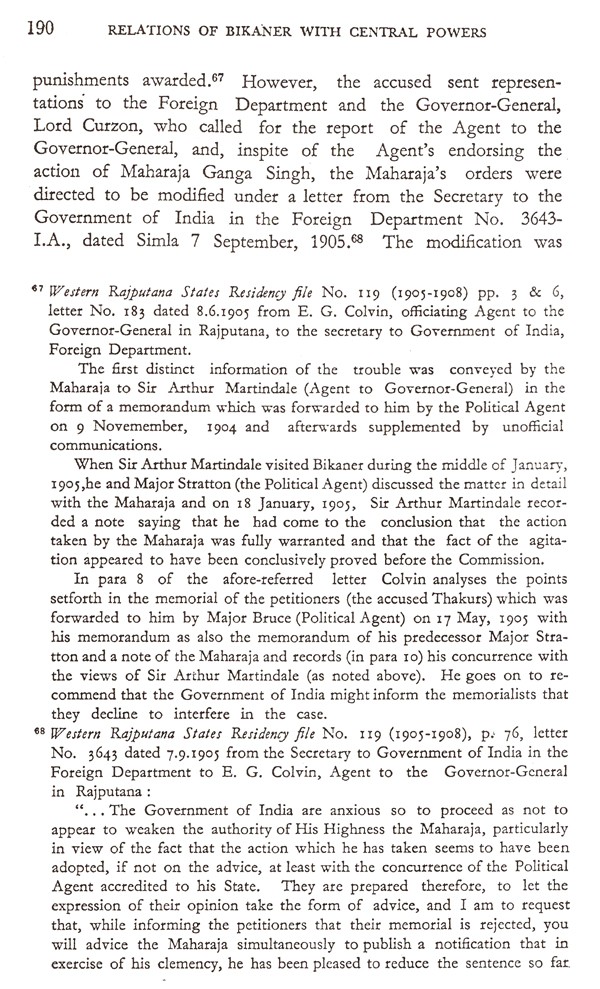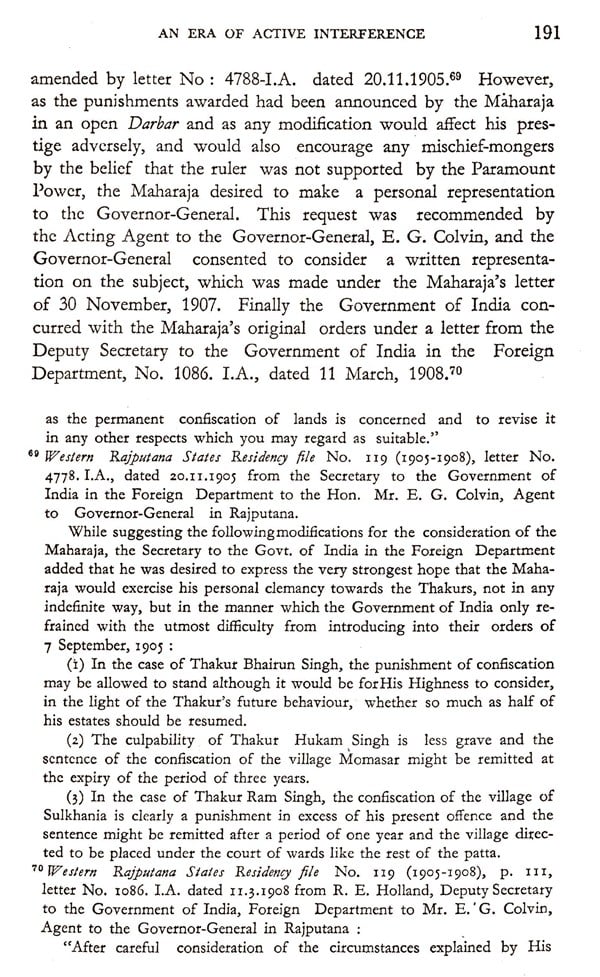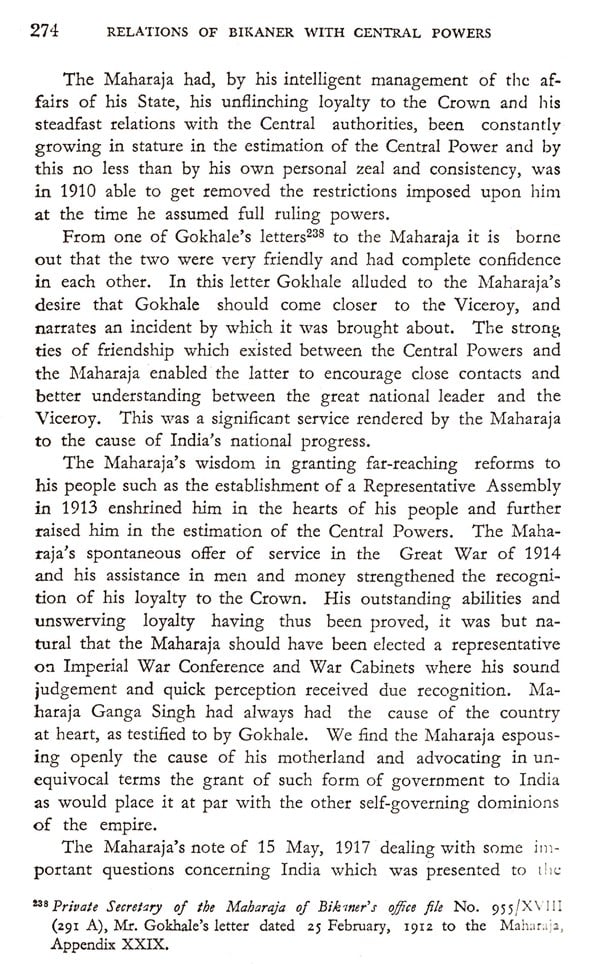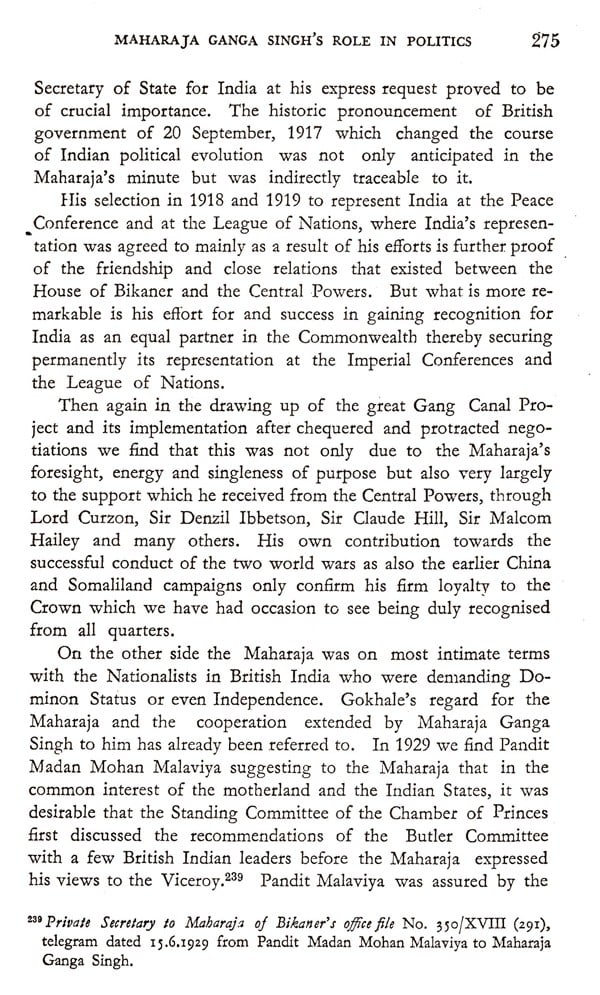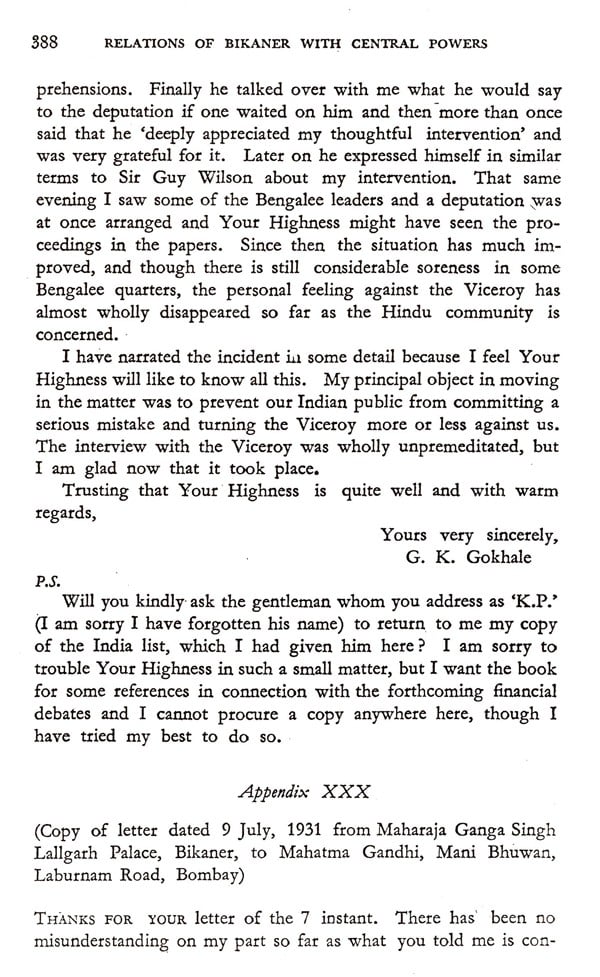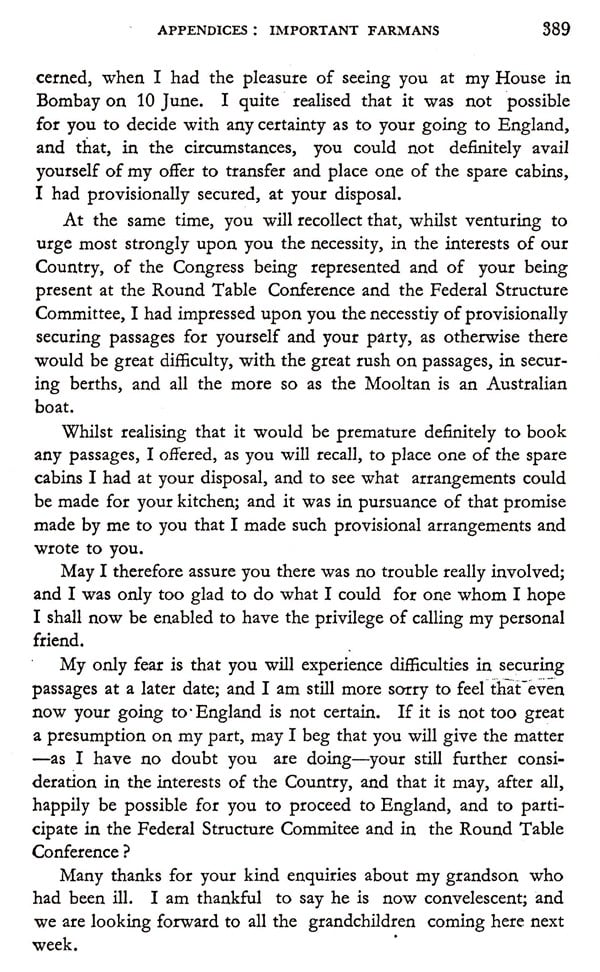
The Relations of the House of Bikaner With the Central Powers (1465-1949)
Book Specification
| Item Code: | UAB380 |
| Author: | Karni Singh |
| Publisher: | Books Treasure |
| Language: | English |
| Edition: | 2011 |
| ISBN: | 9788190042238 |
| Pages: | 450 |
| Cover: | HARDCOVER |
| Other Details | 9.00 X 6.00 inches |
| Weight | 760 gm |
Book Description
THIS BOOK ATTEMPTS to offer a comprehensive record of the relationship which the House of Bikaner built with the rulers of Delhi during a span of close to five centuries. The material for the book is found both in original sources and numerous works of modern writers. It was a relationship between two bodies so dis similar in their aims and objects that a research student has often to change the angle of his approach to suit the changing pattern of history over the centuries. The nature of such a relationship largely depended upon the temperaments and character of the imperial authorities and the rulers of Bikaner. The reign of a Maharaja witnessed so many vicissitudes in his political and personal relationship with the rulers of Delhi that it took innumerable turns every now and then. In this book an attempt has been made to examine in detail the causes and consequences of all these reactions and changes disturbing the smooth continuity of the relationship, at times straining the relationship and at other times cementing it further.
The narrative opens up amidst a tumultuous war and din when, dissappointed in his hopes to recover the seat of his ancestors in Central Asia, Babar raided India, defeated the Lodis and started towards Kanwaha with a view to founding a new empire. In the bloody battle of Kanwaha where the Rajput chivalry, daunt less even in death, was blasted before Babar's terrible Tur kish ordnance. Rao Kalyanmal, while still heir-apparent, took part against the invading Mughal hordes; Rao Jaitsi successfully repelled a Mughal invasion and forced Kamran to flee back. After this period of clash and conflict, the House of Timur as well as the House of Bikaner realised the importance of their respective adversaries and entered into a relationship which was both cordial and co-operative. While the imperial Mughals were always prepared to respect gallant fighters whose assistance they needed for curbing the Afghan power, the rulers of Bikaner found that a career in the imperial service could afford wide opportunities for statecraft and soldiering for which they were so well-fitted. This went to constitute the corner-stone of a happy relationship under whose aegis Raja Rai Singh became one of the most distinguished generals of emperor Akbar, saw service on every frontier of the Empire and was rewarded by the grant of the exalted rank of Commander of five thousand, a grant of territory and the title of Raja.
Thereafter, Raja after Raja won glory and honour in defence of the widespread empire of the Mughals. But the empire which the house of Bikaner had supported so long and so faithfully, ultimately started crumbling to decay and a time came when it could no longer maintain order within its boundaries and became the merest shadow of a great name. With the downfall of the Mughal empire comes to close a brilliant era of political and military relationship which made it possible for the rulers of Bikaner to show their valour in different parts of India and establish their reputation far and wide.
After the downfall of the Mughal Empire till the advent of the British, Bikaner enjoyed practically complete independence; neither the depredations of the Pindaris, nor the adventures of the Marathas could cause any suffering to the Rathore principality of Bikaner situated in the extreme north amongst the Rajputana States, more particularly because of its position of isolation. Even then, the Rathore rulers of Bikaner found their position untenable owing to the forces of internal anarchy which practically forced Maharaja Surat Singh to welcome the terms which the rising power of the British offered.
In 1818, a Treaty of Perpetual Friendship, Alliance and Unity of interests was signed; a treaty which was observed in spirit as well as in letter by both the high contracting parties till the year 1947 when the British paramountcy lapsed. During the period of British paramountcy, the House of Bikaner always stood as an ally in support of the British empire whenever necessity arose. In the first Afghan war (1838-42), camels were supplied for the Kabul expedition and the Bikaner troops had seen active service during the first Sikh war of 1845-46 on which occasion, guns and ammunition were supplied as also assistance given in securing safe transport of supplies as well as in hunting down freebooters. During the second Sikh War (1848-49), a body of horse and artillery was sent to co-operate with the British troops at Ferozepore and camels were supplied for the use of the British army. The traditional military prowess of Bikaner was demonstrated in the suppressing of the Mutiny (1857) by rescuing and affording refuge to innocent relatives and supplying the wants of and assisting actively the British operations in Hansi and Hissar. In the second Afghan war of 1878-79, an offer was made placing the services of the entire army of the State at the disposal of the British Government but though availing of the offer was not deemed necessary, eight hundred camels were supplied for the use of the British army. The Bikaner forces, under the personal command of Maharaja Ganga Singh, took active part in the China War (1900-01) and were mentioned in despatches. During the Somaliland campaign (1902-04), the Ganga Risala (Bikaner Camel Corps) saw active service and took part in fighting on several occasions. The services of the Bikaner State forces in the Great war (1914-18) are manifold and have been mentioned in brief in the main text. During the third Afghan War (1919) also, Maharaja Ganga Sing made an offer of his personal services as well as those of the Bikaner State forces, but they were not availed of. On the outbreak of World War II, Maharaja Ganga Singh offered his personal services so also Maharaja Sadul Singh (then heir-apparent). Maharaja Ganga Singh also proceeded on a tour of the Middle East accompanied by the author. The Bikaner troops saw active service in Burma, Aden and the Middle East.
During the period of five centuries, twenty-two rulers ruled over Bikaner. Out of them, eighteen took part directly in various wars, campaigns or internal military operations. This proves beyond any doubt that the relationship which the House of Bikaner had built with the rulers of Delhi, was intimate and extremely important. The main aim of this investigation and research thus has been to examine critically the factors which vindicated the necessity of such a relationship and pushed it on. Special efforts have been made to go deep into the motives of the contracting parties and evaluate objectively the various vicissitudes disturbing its continuity.
Maharaja (Dr.) Karni Singh (1924-88), the 23rd Maharaja of the erstwhile State of Bikaner, was a multi-faceted personality. An able parliamentarian, a world famous shooter, a welknown philanthropist, and above all, a scholar possessing much knowledge of history, Dr. Karni singh, undoubtedly, by his present work titled 'The Relations of the House of Bikaner with the Central Powers from 1465 to 1949', made his mark as a great historian of the time. His father Maharaja Sadul Singh (1902-50) had played a leading part, especially in the process of the entry of the princely States to the Constituent Assembly, followed by their accession and integration to the Dominion of India; and alluding to his patriotic role Sardar Patel had called him 'The co-architect of India's unity'. Dr. Karni Singh's grandfather, Maharaja Ganga Singh (1880-1943), was a regal patriot, a great builder, gifted with wisdom and a broadminded outlook in managing public affairs and relations with the British Empire. Dr. Karni Singh not only proved himself worthy of the traditions of the House of Bikaner, but, at the same time by his many-sided achievements he enhanced the fame of the royal house. The fame that he achieved was less based on his lineage, but more on his own contributions in the fields of politics, sports and scholarship.
Dr. Karni Singh was an elected Member of Indian Parliament (Lok Sabha) for twenty-five years (1952-77) from Bikaner-Churu parliamentary constituency. Imbued with socialism, his heart was close to people who were under-privileged. Whatever salaries and allowances, he had received as Member of the Lok-Sabha, were paid in the form of stipends and scholarships to the needy, meritorious boys and girls of his region. As a parliamentarian, he was held in high esteem.
Dr. Karni Singh's shooting career extended to nearly three de cades, beginning from 1950's. He was an excellent Clay Pigeon shooter and was regarded as one of the best of his generation in India and the world. He had won gold, silver or bronze medals at various shooting championships either World Olympics, or Asian or World Shooting Championships. His shooting experiences are recorded in the book : "From Rome to Moscow: The Memories of an Olympic Trap Shooter", written by him. He was the recipient of the country's highest award in sports, namely, the ARJUNA AWARD in 1962. India today occupies pride of place in shooting, this is mainly because of the impetus provided by Dr. Karni Singh to Shooting Trap and Skeet.
In addition to his parliamentary, sports and social service activities, the Maharaja was a historian of first order. His present work, "The Relations of the House of Bikaner with the Central Powers from 1465 to 1949', first appeared in 1974; and is now being published again to meet the demands of scholars and libraries. Based on primary sources, the work is one of the most reliable and authenticated on the history of the Bikaner State, beginning from the founding of the State in the fifteen century, to its role and relationship with the Mughal and the British Central Powers, which had been based on the twin elements of dignity and sacrifice. The nature of the relationship was either smooth, or moved up and down, depending upon the circumstances, temperaments and interests of the imperial authorities and the rulers of Bikaner. Precise and up-to-date, it is quite the best work that Maharaja Karni Singh had produced. The work is more than a tale of the Bikaner's past, dead and buried, it is equally a well of information and facts, critically dissected and evaluated, and inseparably linked with contemporary events of great significance. It is doubtful whether there is any historian, dead or alive, who knew or knows more about the history of the State than Maharaja (Dr.) Karni Singh. Owing to his remarkable analysis, creative insight and brilliant scholarship, the Maharaja's present work is a pioneering one on the mod ern history of Bikaner. No one can advance a step further in under standing the historical legacy of the State, without first paying a homage to the Maharaja's present work. The work can be rightly reckoned among the great treasures of Bikaner's social, political and cultural heritage.
The book is intended for historians, researchers, public figures and the general readers. In fact, it is a contemporary classic of Bikaner's history that teaches, inspires and elevates the reader.
**Contents and Sample Pages**

